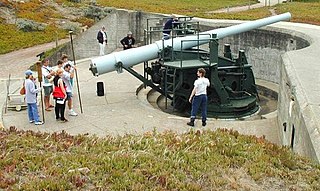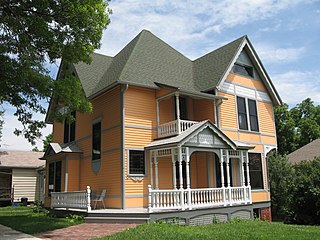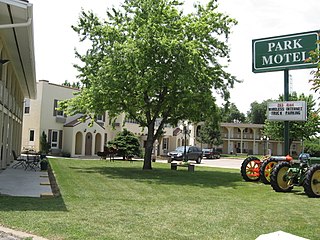
Denison is a city that is part of Denison Township and East Boyer Township in Crawford County, Iowa, United States, along the Boyer River. The population was 8,298 at the 2010 census. It is the county seat of Crawford County.

The Eisenhower Birthplace State Historic Site is located at 609 S. Lamar Avenue in Denison, Grayson County, in the U.S. state of Texas. President Dwight D. Eisenhower was born in the house on October 14, 1890, the first United States President to be born in Texas.

Clarence Duncan Chamberlin was an American pioneer of aviation, being the second man to pilot a fixed-wing aircraft across the Atlantic Ocean, from New York to the European mainland, while carrying the first transatlantic passenger.

The Chamberlin is a retirement community in Hampton, Virginia, overlooking Hampton Roads at Old Point Comfort. It was formerly known as the Chamberlin Hotel, named for the famed restaurateur and original owner John Chamberlin. The nine-story building sits on historic Fort Monroe and overlooks Fort Wool. Listed on the National Register of Historic Places, it has been renovated from its former life as a hotel into a luxury retirement community for people aged 55 and up.

Battery Chamberlin is an artillery battery in the Presidio of San Francisco, San Francisco, California, United States. The battery is named in honor of Captain Lowell A. Chamberlin, who had served with distinction in the Civil War. It was added to the National Register of Historic Places on November 7, 1976.

Black Hawk State Park is a state park of Iowa, USA, in the town of Lake View. The park includes land, campgrounds, trails, game preserves, historic structures, and the waters of Black Hawk Lake. Also it is home to the Lake View Water Carnival. This event is held the third full weekend in July every year, and includes many family-friendly activities including a Water Parade. Three sections of the park were listed on the National Register of Historic Places in 1991.

The Embassy of Uzbekistan in Washington, D.C.,, is the diplomatic mission of the Republic of Uzbekistan to the United States. The current ambassador of Uzbekistan to the United States is Djavlon Vahabov. The embassy is located at 1746 Massachusetts Avenue NW on Embassy Row in Washington, D.C., between Scott Circle and Dupont Circle. Constructed in 1909, the Clarence Moore House is an example of Beaux Arts architecture in blond Roman brick with limestone dressings; it was used by the Canadian government until the 1980s. The house was listed on the National Register of Historic Places (NRHP) on April 3, 1973. The building is also designated a contributing property to the Massachusetts Avenue Historic District and Dupont Circle Historic District, which are both listed on the NRHP.

The John T. and Marietta Carey House is a historic residence located in Denison, Iowa, United States. The house is associated with John Carey, who served for six years as Denison's mayor. During that time the city's sewer system was put in, street signs were put up, preparations were made for mail delivery, the Carnegie Library and the courthouse were built, a telephone exchange was installed and the city more than doubled in size. President Theodore Roosevelt and Treasury Secretary L. M. Shaw, a former Iowa governor, visited Denison when Carey was mayor. He also served in county government. Marietta (Greek) Carey was the daughter of early pioneers to the county, and she was one of the first people born in the county. The two-story, frame, Queen-Anne style house was built in 1893. It is a mail-order house from the George F. Barber & Co. in Knoxville, Tennessee. The house was listed on the National Register of Historic Places in 2000.

The Park Motel is a historic building located in Denison, Iowa, United States. It is an example of a well-preserved highway motel during the early age of motoring. It appears this is also an early example of a motel in Iowa and may be one of the earliest in the Midwest.

The William A. McHenry House, Denison, Iowa, is on the National Register of Historic Places. It is maintained as a museum by the Crawford County Historical Society and is open for tours.

The Crawford County Courthouse is in Denison, Iowa, United States, the county seat of Crawford County. It was listed on the National Register of Historic Places in 1981. The courthouse is the second building the county has used for court functions and county administration.

This is a list of the National Register of Historic Places listings in Audubon County, Iowa.

This is a list of the National Register of Historic Places listings in Woodbury County, Iowa.

The House at 18 Park Street, also known as the Clarence A. Van Derveer House, is a historic house at 18 Park Street in Wakefield, Massachusetts. The 1.5 story Craftsman/Bungalow style house was built in 1922 by Clarence A Van Derveer, a real estate broker who lived next door and subdivided his lot to build this house. It has classic Craftsman features, including exposed rafters under extended eaves, and paneled porch pillars and rails.
Chamberlin House may refer to:

The former Lake City Public Library is a historic structure located in Lake City, Iowa, United States. Efforts to establish a library began as early as 1889 when community socials were held to raise money for books. Women in the community, however, would not form a community library association until 1905. They sought donations of books and money from the community and were able to set up a subscription that year in the old primary building next to Central School. By 1908 there were 1,500 volumes in the library. The Association proposed to the city council in February of the same year that they turn their holdings over to the city for a free library. The council agreed to submit the proposal to the voters and the Association petitioned the Carnegie Corporation of New York for funds to build a new building. They accepted Lake City's application for a grant for $7,500 on May 8, 1908, and approved the library proposal in early June. S.T. and E.S. Hutchison donated the property. Denison, Iowa architect Edgar Lee Barber designed the Neoclassical building that was built by Nelson Construction Company. It opened in April 1910. There was no formal dedication. The building was listed on the National Register of Historic Places in 1990. The community has subsequently built a new library, and this building now houses a commercial business.

The Oskaloosa Monthly Meeting of Friends Parsonage is a historic building located in Oskaloosa, Iowa, United States. Its historic significance is found in its association with nearby William Penn University in the context of the Quaker testimony in Oskaloosa. The country's entry into World War I created problems for the Quaker's Peace Testimony. The Oskaloosa Monthly Meeting counseled students from the college about military conscription and pacifism. Because of this the parsonage was vandalized in 1917 with yellow crosses painted on the house. The congregation's pastor, Clarence Pickett, was tied to a spring wagon and led through town. Some vandalism also occurred during World War II, including yellow paint smeared on the parsonage.

The Rogers-Knutson House is a historic building located in Clear Lake, Iowa, United States. Built in 1895, the Queen Anne Victorian house was built for Francis M. Rogers. He was a farmer, served in the Civil War, was the clerk of court and ran a clothing store in Mason City before he bought the private First National Bank in Clear Lake in 1889. He went on to serve on the board of education, city council, and as mayor of Clear Lake. Clarence and Hazel Knutson bought the house in 1920. Clarence was also a banker and served as mayor. Knutson worked in the family hardware store, served in the Iowa Legislature, and served as the president of the Iowa Hardware Mutual Insurance Company from 1931 to 1960. Hazel Knutson was involved with a variety of civic clubs and organizations, including conservation efforts. She also served as president of the Iowa League of Women Voters. Howard and Francie Sonksen bought the house in 1972. Howard was a teacher and Francie worked from home as a massage therapist. They brought the home back to its original glory, such as removing the wall-to-wall carpeting, refinishing the beautiful wood floors, restoring the solarium and the outside pond pumps back to working order.

The Mason City Public Library is located in Mason City, Iowa, United States. The building that was funded by Andrew Carnegie, and is now an office building, was listed on the National Register of Historic Places in 1989. It was included as a contributing property in the Mason City Downtown Historic District in 2005.

The Olmsted Family Farmhouse, also known as the Olmsted-Urban House, is an historic building located in Urbandale, Iowa, United States. Leander and Charlotte Olmsted from Auburn, New York acquired 80 acres (32 ha) of land in Polk County, Iowa in 1867. They built a house on the property where they raised their sons Millard and Clarence, and bought additional land for their farm. In 1904, about the time Millard married his wife Olive, Leander had this two-story, frame, American foursquare house built.






















